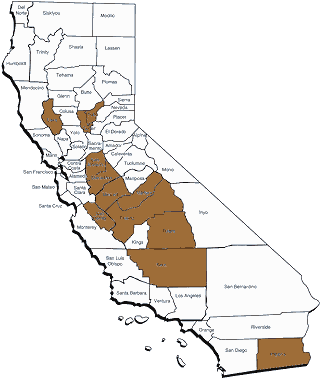A May 3rd news story listed the 20 most "stressed" counties in the United States. Twelve of the 20 counties (60%) are in one state, California. According to the the analysis, "stress" is measured by adding the unemployment rate plus the foreclosure rate plus the bankruptcy rate. Looking at the interactive map, the California counties suffer primarily from very high unemployment.
- Imperial County, Calif., 31.27
- Merced County, Calif., 28.29
- Lyon County, Nev., 27.96
- San Benito County, Calif., 27.26
- Sutter County, Calif., 26.41
- Yuba County, Calif., 25.8
- Stanislaus County, Calif., 25.46
- Iosco County, Mich., 24.89
- San Joaquin County, Calif., 24.78
- Nye County, Nevada., 24.19
- Lapeer County, Mich., 24.03
- Cheboygan County, Mich., 23.89
- Luna County, N.M., 23.82
- Lake County, Calif., 23.78
- Kern County, Calif., 23.62
- Tulare County, Calif., 23.17
- Madera County, Calif., 23.04
- Fresno County, Calif., 22.72
- Clark County, Nevada, 22.65
- Boone County, Ill., 22.59

Many of the affected counties are part of California's Central Valley Project (CVP), the critical lifeline delivering water to California's Central Valley (San Joaquin Valley) farmers. Here are these same counties plotted on top of a map of the CVP.
Click image to enlarge in separate window.

The CVP's canals are often in the news due to a controversial decision to reduce water deliveries in order to protect an endangered fish called the delta smelt.
Wall Street Journal: "California's Man-Made Drought"
online.wsj.com/article/SB10001424052970204731804574384731898375624.html
Newsweek: "Dying on the Vine: Water Shortage Wilts California's San Joaquin Valley"
www.newsweek.com/id/211381
Driving through the Central Valley last Summer, it was the driest that I had seen. Some farmers claim that this is all a crisis created by the government, as shown by this now-famous sign reading "Congress Created Dust Bowl."

No doubt, government policies have complicated deliveries. However, as described in a response by the Department of the Interior, the delta smelt isn't the only reason for the lack of water deliveries. California has suffered through three years of drought and there are long-neglected improvements required to the CVP. Some of these fixes require careful coordination between California state politicians and the federal government.
While I don't have conclusive evidence showing a direct correlation between the lack of water and unemployment, the link appears relatively obvious. Agriculture depends on water and employment in the affected counties relies heavily on agribusiness. It is also obvious that people in the affected counties are indeed stressed.
More Information ...
Dead and Dying: California's Central Valley Dust Bowl
beetlebabee.wordpress.com/2009/06/01/dead-and-dying-californias-central-valley-dust-bowl
Central Valley Project
en.wikipedia.org/wiki/Central_Valley_Project
L.A. Times: "U.S. speeds up water deliveries to San Joaquin Valley farmers"
articles.latimes.com/2010/jan/27/local/la-me-water-drought27-2010jan27